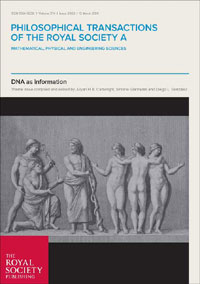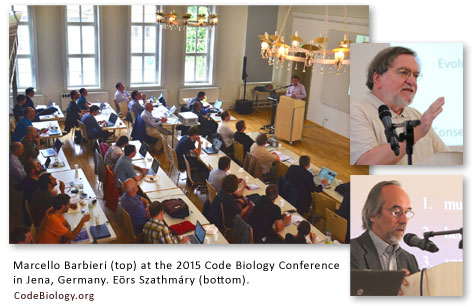For those who are unfamiliar with The Royal Society, it’s an academic organization whose membership includes many of the world’s most eminent scientists, and is “the oldest scientific academy in continuous existence”. In loose terms, they are a British forbearer to many of the various Academies of Science sprinkled throughout the nations of the world. From their mission statement:
The Society’s fundamental purpose, reflected in its founding Charters of the 1660s, is to recognize, promote, and support excellence in science and to encourage the development and use of science for the benefit of humanity.
This article isn’t necessarily about the Royal Society, except for the fact that it serves as the genesis of the story, and also a proper backdrop to frame the issues at hand.
What is at issue is the void that seems to exist between the average working biologist and the fundamental reality that DNA (the genome) is a genuine representational medium. It operates in a system that translates the representations it uses to encode biological information into long-term memory. It is not sort-of-like information; it is not kind-of-like information. From a physics perspective, it functions exactly like the words you are reading right now. In fact — again from a physical systems perspective — only genetic encoding can match the variety and open-ended content of the words on this page. The genetic code and recorded language are the only two physical systems like this in the entire cosmos. They use spatially-oriented representations and a reading-frame code. It is the organization of arbitrary constraints that enables the combinatorial encoding of effects. In the total sum of human knowledge, they are a set of two – with no others.
In their March 2016 volume, the Philosophical Transactions of the Royal Society published a special collection of papers under the no-nonsense heading “DNA as Information”. The content of those papers reflect the fact that the study of information remains a huge subject in the sciences, with an array of research opportunities in every direction. Contributions among the twenty-odd papers in the collection include such topics as semantics, mathematics, physics, encoding, measurement, complexity, and the role of meaning in biology.
This issue of Philosophical Transactions is where this story begins. More specifically, it begins with a particular paper (presented in that collection) by a well-respected Italian professor and researcher, Marcello Barbieri, who has for many years promoted a paradigm shift to biological semiosis (biosemiosis) and who is currently advancing this effort under the moniker “Code Biology”.
In opening his paper, Dr Barbieri addresses the central issue of this article:
Molecular biology is based on two great discoveries: the first is that genes carry hereditary information in the form of linear sequences of nucleotides; the second is that in protein synthesis a sequence of nucleotides is translated into a sequence of amino acids, a process that amounts to a transfer of information from genes to proteins. These discoveries have shown that the information of genes and proteins is the specific linear order of their sequences. This is a clear definition of information and there is no doubt that it reflects an experimental reality. What is not clear, however, is the ontological status of information, and the result is that today we have two conflicting paradigms in biology. One is the ‘chemical paradigm’, the idea that ‘life is chemistry’, or, more precisely, that ‘life is an extremely complex form of chemistry’. The other is the ‘information paradigm’, the view that chemistry is not enough, that ‘life is chemistry plus information’.
A link to Marcello Barbieri’s abstract is available on the Royal Society website here.
We pick up the story on the reaction side of its publication; the reaction to these observations by an average American scientist — a published biologist — who voices his point of view on the World Wide Web.
In this article it will not be necessary to perform any critical review of the biologist’s comments; one can tell within just a few words the gist of his position. He clearly has no questions about the “life is chemistry” paradigm he was taught at his university, and he clearly finds any other suggestion to be simply absurd. In his critique of Barbieri’s paper, he begins on his left foot:
Critic: “The first thing that I need to point out is that the author is not a biologist. He is a semiotician (someone who studies symbols and meanings). This will readily explain some of his more idiotic claims …”
I entered the conversation to say that he was tremendously misinformed about Marcello Barbieri’s qualifications, and I posted a short passage of text copied from Barbieri’s webpage about his background. I was also little surprised by the complete disregard for the source of the publication itself – the world’s “oldest scientific academy in continuous existence”. Not only can Barbieri be ignored, but the Royal Society is publishing “idiotic claims” about biology – or so it seems.
But there is certainly more to this. I believe there are possibly three things at work in the reaction presented above. First and foremost are the material facts themselves; i.e. the observation of genuine representations and arbitrary constraints (formalized in memory) inside the cell are difficult things to explain by the physical properties of matter. After all, the very essence of genetic translation is that it systematically decouples the production of effects from sheer determinism (physicalism), making possible the full range effects necessary for biology to exist. In other words, a system that functions only by locally eliminating your favorite explanation is a difficult nut to crack.
Secondly, Barbieri’s paper was presented (in this particular instance) under the rubric of philosophy, which (as a general rule) is often looked down upon by certain classes of scientists. Not surprisingly, these often include those sciences (like evolutionary biology and theoretical physics) that promote the notion that they are answering mankind’s biggest questions. As I wrote on Biosemiosis.org, this is cavalier conduct in light of the actual evidence. In any case, for many people, the idea of systematic learning without philosophical grounding is a cart without a horse. The practice of systematic learning is itself a philosophy.
But thirdly, there is something even more central to this critic’s comments; he isolates the lowly “creationist” as the key figure in his response. They are, as it turns out, the real impetus for his comments. He begins “So, it seems that creationists have been spamming this article so I’ll analyze it”. By using the word creationists here, some might suggest the critic intends to attack only those who believe such things as the earth being six thousand years old, for instance. But I think we can fairly assume he intends to attack anyone who believes that life on earth is the product of a creation, and of course, anyone who could believe such a thing obviously deserves to be attacked. The mere appearance of the word provides sufficient license to trivialize both the observations being made, as well as any outfit that publishes them.
Now, I have no evidence one way or another that anyone or any group has piled on to Barbieri’s paper – and it makes not one ounce of difference either way. The real issue here is that verifiable physical evidence is being routinely belittled and ignored simply because it doesn’t conform to the personal metaphysics of proper-thinking biologists — and clearly this is about metaphysics. It’s about the treatment and teaching of metaphysics in science. While the self-appointed defenders of science posture about the provisional nature of science, make no mistake; no physical evidence is allowed to take root if it leads to the unimaginable proposition that today’s biologists could be wrong in their personal beliefs about ultimate reality.
And this view doesn’t merely exist among anonymous biologists posting on the web; it is the dominant view found throughout biology at all levels. For instance, Larry Moran is a respected Professor of Biochemistry at the University of Toronto, and has written multiple textbooks on the subject. But four and a half years ago, I asked him for a clear statement as to whether or not the genome (DNA) actually contained information. He replied:
In common parlance we refer to these sites as containing “information” in the form of specific nucleotide sequence. It’s a very useful analogy and I think everyone knows what we mean when we use it. Nobody expects it to conform to the meanings of “information” in other disciplines. Nobody, that is, except some IDiots who like to play semantic word games instead of addressing real science. I hope you’re not one of those people.
The problem with this, of course, is that investigator expectations are a secondary concern; the genome functions exactly like language, and vice versa.
In any case, the war on outcast metaphysics is made evident again and again. It’s a socio-political enterprise, and when it rises to the level of ignoring valid evidence, it becomes an enterprise aligned against reason itself. This critic of semiosis had no idea that semiosis was physically identifiable, and he doesn’t want to know.
–Upright BiPed
The remainder of my exchange with the critic follows below. What it lacks in debate it thankfully makes up for in brevity. The critic clearly threw in the towel, rather than show any interest in the science.
UB: (posted Barbieri’s extensive background…)
– – – – – – – – – – – –
Critic: Thank you for the correction. From the references that immediately jumped, he seemed to study biosemiotics. That’s very disappointing that he actually has conducted research because he is so wrong-headed in his article.
With regards to my name, I’m a published biologist. I’m a scientist and my name is Sam.
– – – – – – – – – – – –
UB: Hi Sam. Good to know. Take care.
By the way, he is entirely correct in his paper, you are just unaware of the issues. It happens.
– – – – – – – – – – – –
Critic: No he isn’t. I gave very good reasons. This is far closer to my area of research than his.
– – – – – – – – – – – –
UB: Barbieri states that the code is not reducible to physics. He is correct. Like all code systems ever known to exist, the genetic translation system contains a natural (and necessary) discontinuity between the arrangement of the medium and the determination of its effect within the system. This local discontinuity is what makes it possible for a spatial arrangement of bases in a codon to specify a particular amino acid during synthesis. It is what establishes combinatorial permutations and enables open-ended heredity. I can appreciate the fact that this all sounds foreign to you, but that is only because you are unaware of the data – which has been documented in physics literature starting about half a century ago by physicists such as Howard Pattee and others.
– – – – – – – – – – – –
Critic: “Like all code systems ever known to exist, the genetic translation system contains a natural (and necessary) discontinuity between the arrangement of the medium and the determination of its effect within the system.”
There is no discontinuity. You must’ve never taken molecular biology.
“This local discontinuity is what makes it possible for a spatial arrangement of bases in a codon to specify a particular amino acid during synthesis.”
How so? This is just a bald assertion.
“It is what establishes combinatorial permutations and enables open-ended heredity.”
Again, bald assertion.
“I can appreciate the fact that this all sounds foreign to you, but that is only because you are unaware of the data – which has been documented in physics literature starting about half a century ago by physicists such as Howard Pattee and others.”
How about you stop condescending to someone who wrote his Master’s thesis on the dynamics of the genetic code? Please make an argument rather than bald assertions you supercilious imbecile.
– – – – – – – – – – – –
UB: “There is no discontinuity.”
Like I said, the local discontinuity is an organizational necessity. The arrangement of bases in a codon does not determine which amino acid is presented for binding. I would think this should be obvious to someone of your training.
– – – – – – – – – – – –
Critic: “The arrangement of bases in a codon does not determine which amino acid is presented for binding.”
Strictly speaking, that is true, but there are a lot of contingencies built into the structure of the code. For example, we have the third base wobble. We also have the fact that more similar amino acids correspond to more similar codons. Thus, there seem to be contingencies built into the code. But, even if I grant you this, where does it get you in an argument?
– – – – – – – – – – – –
UB: “where does it get you in an argument?”
This is one of the empirical markers a physicist would use to identify the organization of a semiotic code, i.e. the preservation of the discontinuity between the arrangement of the medium and the determination of its effect. The cell accomplishes this by isolating the establishment of the code from the reading of the codons, i.e. the amino acid-to-anticodon association is temporally and spatially isolated from the codon-to-anticodon association. This discontinuity is a physical necessity for translation to occur, and is evident in all instances of semiotic translation.
But that is just the first marker that a physicist would look for. There are others. For instance, genetic translation employs a reading frame code using combinatorial permutations. This requires the arrangement of the bases in each codon to be independent of the minimum total potential energy state of the medium. In other words, a pheromone (for instance) is an informational medium that is recognized in its system by its three-dimensional structure, and that structure is determined by its minimum total potential energy. But in order to enable combinatorial permutations, the arrangement of the medium must be independent of minimum total potential energy – which both DNA and RNA are. This is what physically enables the system to have the informational capacity it requires to describe itself into memory (i.e. to begin the cell cycle, and heredity). It is also what enables the efficient transcription of that high-content information from one medium to another.
These are the types of empirical observations that a physicist (like Pattee and others) would be acquainted with, as well as someone like Barbieri. Or John von Neuman. Or Francis Crick.
You are not acquainted with them, and it’s a sure bet they didn’t appear in your masters thesis on the dynamics of translation. No sweat. I am sure your thesis described other areas of interest in a competent manner. But when you step out and rant on areas of empirical findings that you are uninformed about, you make a mistake. In order to organize the heterogeneous cell, you must first be able to specify a thing and place it under temporal control. This is what protein synthesis does, and the translation of an informational medium is the means to accomplish that effect. But the translation of an informational medium requires one arrangement of matter to serve as a representational medium (codons), and another arrangement of matter to establish what is being represented (aaRS). After all, no object in the material universe inherent specifies any other object in the material universe. Nucleobases do not represent or specify amino acids. They have to be organized in a discontinuous translation system (i.e. semiosis) in order to do so. And that is exactly what is found inside the cell. The material observations that identify the system aren’t even controversial.
– – – – – – – – – – – –
Critic: Thanks for the tripe.
“This discontinuity is a physical necessity for translation to occur, and is evident in all instances of semiotic translation.”
The discontinuity isn’t a physical necessity. You could easily imagine a scenario where amino acids were necessarily assigned to anticodons by chemical properties of tRNAs. I’m sorry but if you can’t get that right, you’re pretty hopeless, idiotically pedantic, and a navel gazer. Goodbye.
– – – – – – – – – – – –
UB: In logic, that’s called “special pleading”. Your imagination, frankly, doesn’t mean diddly. It doesn’t provide you with any exemptions.
The minimum requirement for the origin of the system is established by what is physically necessary to record and translate the amount of information that the system needs to successfully describe itself into memory. On this front, there is very little room. A cell that cannot provide a record of itself cannot begin the cell cycle. A cell that cannot translate a record of itself also cannot begin the cell cycle.
To accomplish what must be accomplished, several of these individual associations (generous estimates typically run between 12 to 15) will need to occur at the same time and place, while the details of their construction are simultaneously encoded in the very information that they make possible.
Odd, isn’t it. Nature passed up on the fully determined (comparatively easy) associations lurking in your imagination, and instead (already faced with an almost vertical face to climb) picked an unnecessary system that preserves the discontinuity between the arrangements and their effects. And even odder still, every system of translation that has ever been examined has followed that same pattern.
Special pleading indeed. Goodbye.
This article was posted from ComplexityCafe.com


